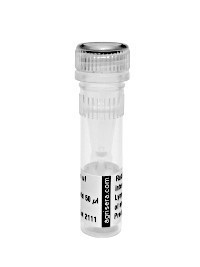1

Anti-P-Tyr | Phosphotyrosine (clone G104)
AS10 705 | Clonality: monoclonal | Host: Mouse | Reactivity: phosphotyrosine
- Product Info
-
Sub class: IgG1 Immunogen: Phosphotyrosine, alanine and glyceine in a 1:1:1 ratio polymerized in the presence of keyhole limpet hemocyanin KLH with 1-ethyl-3-(3’-dimentrylaminopropyl) carbodiimide
Host: Mouse Clonality: Monoclonal Purity: Total IgG. Format: Liquid Quantity: 100 µg Storage: Store at -20°C for one year; once reconstituted make aliquots to avoid repeated freeze-thaw cycles. Please remember to spin the tubes briefly prior to opening them to avoid any losses that might occur from material adhering to the cap or sides of the tube. Tested applications: Immunoprecipitation (IP), Immunofluorescence (IF), Immunohistochemistry (IHC), Western blot (WB) Recommended dilution: 1 : 1000 (WB) - Reactivity
-
Confirmed reactivity: Antibody reacts with phosphotyrosine and detects the presence of phosphotyrosine in proteins of both unstimulated and stimulated cell lysated, Does not cross react with phosphoserine or phosphothreonine Not reactive in: No confirmed exceptions from predicted reactivity are currently known - Additional Information
-
Additional information: Protein G purified IgG1 in PBS, pH 7,4 with 0,09 % sodium azide and 50 % glycerol at concentration 1 mg/ml Additional information (application): 1 µg/ml of this antibody is sufficient for detection of phosphorylated tyrosine residues in 10 µg of rat tissue lysate by colorimetric immunoblot analysis - Background
-
Background: Tyrosine phosphorylation is considered to be one of the key steps in signal transduction and regulation of enzymatic activity. Phosphotyrosine antibodies are helpful in facilitating the identification of tyrosine kinase substrates.
- Product Citations
-
Selected references: Garton & Tonks (1999). Regulation of fibroblast motility by the protein tyrosine phosphatase PTP-PEST. J Biol Chem 6:3811-3818.
Tiganis et al. (1999). The protein-tyrosine phosphatase TCPTP regulates epidermal growth factor receptor-mediated and phosphatidylinositol 3-kinase-dependent signaling. J Biol Chem 39: 27768-27775.(IF):
Garton et al. (1996). Identification of p130(cas) as a substrate for the cytosolic protein tyrosine phosphatase PTP-PEST. Mol and Cell Bio 11:6408-6418.(IP):
- Protocols
-
Agrisera Western Blot protocol and video tutorials
Protocols to work with plant and algal protein extracts
Agrisera Educational Posters Collection
- Reviews:
-
This product doesn't have any reviews.


